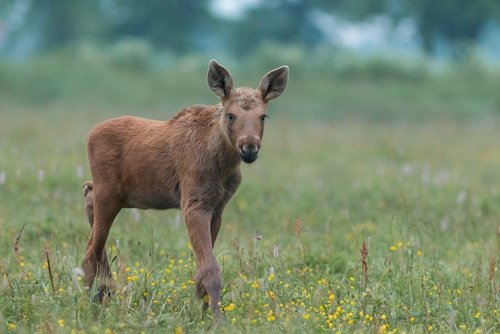Understanding moose population tracking is crucial for effective wildlife management and conservation initiatives. By tracking moose populations, scientists and wildlife biologists gain valuable insights into their behavior, habitat preferences, migration patterns, and overall health. This knowledge helps inform decision-making processes related to hunting regulations, habitat management, and species conservation efforts.
Moose Population Dynamics
Moose are majestic creatures that play a vital role in the ecosystems they inhabit. Monitoring moose numbers allows us to assess population trends over time, detect potential declines or increases in specific regions, and identify factors affecting their abundance. Understanding these dynamics is essential for preserving healthy moose populations and safeguarding the overall biodiversity of our forests.
Overview of methods used for tracking moose populations
Scientists employ various monitoring techniques tailored to different research goals and logistical constraints to gather accurate data on moose populations. These methods include aerial surveys conducted from helicopters or fixed-wing aircraft and ground surveys utilizing transect sampling techniques. Additionally, technological advancements have introduced GPS collars for tracking individual movement patterns and DNA analysis for estimating population size. A comprehensive approach that combines these methods provides a more holistic understanding of moose population dynamics.
Aerial Surveys: Gaining a Bird’s-Eye View
Soaring in the Skies with Helicopters or Fixed-Wing Aircrafts
As we embark on the fascinating world of moose population tracking, let’s take a moment to appreciate the wonders of aerial surveys. Picture this: a helicopter gracefully hovering above vast wilderness or a fixed-wing aircraft gliding through the air, equipped to monitor and assess moose populations. These surveys offer distinct advantages in terms of coverage and efficiency.
By surveying large areas from above, researchers can quickly estimate population size and distribution patterns over expansive landscapes. This method proves particularly useful in remote regions where ground-based surveys are logistically challenging.
Analyzing Moose Numbers from Above
Using helicopters or fixed-wing aircraft allows scientists to cover great distances with relative ease, enabling efficient monitoring of moose populations. Researchers extract invaluable information about moose abundance and distribution across their habitats by employing visual counts or sophisticated imaging systems, such as thermal cameras or LiDAR technology. This knowledge provides insights into individual populations’ health and dynamics and helps inform conservation initiatives aimed at preserving these majestic creatures for generations to come.
Ground Surveys: Getting Up Close and Personal
Transect Sampling Techniques: Walking Through Moose Territory
While aerial surveys soar high above, ground surveys take us to Earth for an intimate encounter with moose habitat. One popular method employed during ground surveys is transect sampling. Researchers establish predetermined walking routes within known moose territories, systematically surveying these transects to collect data on abundance and habitat preferences.
Gathering Valuable Insights on Abundance and Habits
During ground surveys, passionate scientists venture into thick forests armed with knowledge and determination to uncover the secrets of moose populations. Walking predetermined paths, they carefully record signs of moose presence, such as tracks, droppings, and browse lines. Researchers gain valuable insights into moose abundance and habitat preferences by analyzing these indicators and other environmental factors.
These detailed observations help guide wildlife management strategies and aid in preserving suitable habitats for our antlered friends. With aerial surveys granting us panoramic views from above and ground surveys providing intimate encounters on foot, we are now equipped with tools to delve deeper into monitoring moose numbers.
In the next sections, we will explore additional techniques that further expand our understanding of these magnificent creatures’ lives and ecological roles. Brace yourself for a captivating journey through the realm of moose population tracking!
GPS Collars for Moose Tracking
How GPS collars work in tracking moose movements
Regarding monitoring the majestic moose, GPS collars have revolutionized our understanding of their behavior and habitat preferences. These ingenious devices utilize satellite-based positioning technology, allowing researchers to track the movements of individual moose with remarkable precision. The collars are equipped with a GPS receiver that communicates with orbiting satellites, enabling the collection of accurate location data.
This information is transmitted to researchers, providing valuable insights into movement patterns, home ranges, and migration routes. By studying these intricate details, scientists can better comprehend the ecological needs of these magnificent creatures and implement effective conservation initiatives.
Satellite-based positioning technology
The heart of GPS collar tracking lies in satellite-based positioning technology. A network of satellites orbiting Earth sends signals containing precise timing information and location data down to the receivers on the GPS collars worn by moose.
These receivers can determine the collar’s exact position on Earth’s surface by triangulating signals from multiple satellites. This information is typically recorded at regular intervals, creating a comprehensive dataset that reveals where a moose is located and how it moves over time.
Data collection on movement patterns, home ranges, and migration routes
With each transmitted location point obtained from GPS collars, researchers can analyze the movement patterns exhibited by individual moose. By examining location changes over time, they gain insights into daily activity rhythms or seasonal shifts in habitat use. Additionally, this tracking method provides valuable information about an individual’s home range—where it spends most of its time—and helps identify critical migration corridors or preferred feeding areas.
Challenges in using GPS collars for moose tracking
Despite their incredible advantages for monitoring moose numbers and studying their behavior, GPS collars have certain challenges. One such limitation is battery life.
These collars require a power source to operate the GPS receiver and transmit location data, and limited battery capacity can restrict tracking duration. Researchers must carefully consider the balance between collar weight and battery life to ensure it does not impede moose movement or lead to premature collar failure.
Data retrieval and analysis
Another challenge lies in data retrieval and analysis. Once the GPS collars have collected substantial location data, researchers must retrieve these devices from moose to download the stored information for analysis. This process often involves capturing the animals using techniques that prioritize their safety and well-being, ensuring minimal stress during collar removal.
Once obtained, the collected data undergoes rigorous analysis to uncover significant patterns, determine habitat preferences, and inform management strategies. Advanced statistical methods are employed to examine movement rates, identify core areas within home ranges, and even assess interactions between individuals within a population.
GPS collars have undeniably opened up new avenues for studying moose behavior on an unprecedented scale. By overcoming challenges related to battery life limitations and refining data collection techniques, scientists continue to deepen our understanding of these magnificent creatures while actively contributing to their conservation efforts.
DNA Analysis for Moose Population Monitoring
Non-invasive genetic sampling techniques
When monitoring moose populations, researchers have developed non-invasive genetic sampling techniques that avoid unnecessary animal disruptions. Instead of capturing and handling the moose directly, scientists collect hair, feces, or saliva samples left behind by these majestic creatures.
These samples contain valuable DNA, which can be used for individual identification and relatedness analysis. This approach not only minimizes stress on the moose but also allows for repeated sampling over time without disturbing their habitats.
Extracting DNA for individual identification and relatedness analysis
Once the non-invasive samples are collected, scientists extract DNA from them using specialized laboratory procedures. This process involves isolating and purifying the genetic material from hair follicles, fecal matter, or saliva residues obtained in the field.
By analyzing this extracted DNA, researchers can obtain valuable insights into individual moose identity, parentage relationships, and even population structure. This information is crucial for understanding how different individuals are interconnected within a population and plays a vital role in conservation initiatives.
Genetic mark-recapture methods for estimating population size
To estimate moose population size accurately, genetic mark-recapture methods have proven to be highly effective. By combining genetic data obtained from non-invasive samples with statistical modeling techniques, researchers can estimate population abundance without having to physically capture and mark every single individual in a given area.
These methods rely on collecting multiple rounds of genetic samples at different time intervals to build up a comprehensive database of individuals within a population. Statistical models then allow scientists to estimate overall population size based on sample size and capture probability.
Combining genetic data with statistical models
Integrating genetic data with sophisticated statistical models provides valuable insights into the dynamics of moose populations. By understanding the genetic diversity, relatedness, and structure within a population, researchers can gain deeper knowledge of breeding patterns, dispersal behaviors, and gene flow among different subpopulations.
This information not only aids in estimating population size but also helps assess the overall health and resilience of moose populations. Combining genetic data analysis with advanced statistical modeling techniques is an invaluable tool for monitoring moose numbers and informing effective conservation strategies.
Accounting for sampling biases
It is essential to account for sampling biases when using genetic data for estimating moose population size. Since non-invasive samples are often collected opportunistically or based on predetermined survey designs, there can be variations in sample collection effort among different areas or periods. These biases can impact the accuracy of population estimates derived from genetic analyses.
To mitigate these issues, researchers use statistical methods to account for the unevenness in sample capture probabilities and adjust their estimates accordingly. This ensures that the final population size estimates are as accurate as possible and account for any potential biases sampling methods introduce.
DNA analysis through non-invasive genetic sampling techniques has revolutionized our ability to monitor moose populations accurately. By collecting hair, feces, or saliva samples from these majestic animals and extracting DNA for individual identification and relatedness analysis, scientists can estimate population sizes using genetic mark-recapture methods combined with statistical models.
However, it is crucial to account for potential sampling biases when interpreting the results. Through these advancements in DNA analysis, researchers can contribute significantly to conservation initiatives by gaining a better understanding of moose populations and implementing effective management strategies.
Technological Advances in Moose Population Tracking
Remote sensing technologies to monitor habitat changes
The advancement of remote sensing technologies has revolutionized our ability to monitor and analyze habitat changes, which directly impact moose populations. Satellites with high-resolution cameras and sensors capture detailed images of vast areas, providing valuable insights into vegetation density, forest cover, and land use patterns. Additionally, Light Detection and Ranging (LiDAR) data allows us to create three-dimensional landscape models.
By analyzing these data sets, researchers can assess the effects of human activities, such as deforestation or urban development, on moose habitats. This information is crucial for conservation initiatives aiming to preserve suitable habitats for these majestic creatures.
Assessing impacts on food availability and habitat quality
Satellite imagery combined with advanced analytics enables scientists to delve deeper into understanding food availability and habitat quality for moose populations. By examining vegetation indices derived from satellite imagery, researchers can estimate the abundance of plant species that constitute moose diets. Changes in vegetation composition and productivity can be monitored over time, allowing us to identify potential stressors on moose populations’ primary food sources.
Moreover, through remote sensing techniques, we can assess factors like water availability or disturbance patterns that may affect overall habitat quality for moose. This knowledge allows conservationists to develop targeted strategies for maintaining healthy ecosystems that support thriving moose populations.
Drone-based monitoring systems
Drones have emerged as invaluable tools in monitoring wildlife populations due to their maneuverability and ability to capture high-resolution aerial imagery. In moose population tracking, drones provide a unique vantage point for conducting aerial surveillance over large areas efficiently and cost-effectively. With advanced cameras or thermal imaging sensors, drones can detect individual moose from above, even in dense forested areas or during low-light conditions.
This technology allows researchers to estimate moose densities, monitor their movements, and identify potential threats or challenges the population faces. Furthermore, drones equipped with high-resolution imaging capabilities greatly aid in accurate population assessments by reducing the margin of error while counting individuals from above.
Technological advancements in moose population tracking have opened up exciting possibilities for understanding and conserving these magnificent creatures. Remote sensing technologies like satellite imagery and LiDAR data provide crucial information about habitat changes, food availability, and overall habitat quality.
Drone-based monitoring systems offer efficient aerial surveillance capabilities and high-resolution imaging for accurate population assessments. By harnessing these cutting-edge tools, we can enhance our conservation initiatives and ensure the long-term survival of moose populations in their natural habitats.
Technological Advances in Moose Population Tracking
Remote sensing technologies to monitor habitat changes
With the advancement of satellite imagery and LiDAR data, researchers now have access to high-resolution images and detailed information about the landscape. This technology enables them to monitor changes in moose habitats more accurately.
By analyzing satellite imagery, scientists can detect alterations in vegetation cover and land use patterns and even track the impacts of climate change on food availability. This data aids in understanding how these factors influence moose populations and helps inform conservation initiatives.
Drone-based monitoring systems
Drones have proved immensely beneficial in monitoring wildlife populations, including moose. Equipped with high-resolution cameras and thermal sensors, drones provide an aerial perspective that was previously unattainable.
They can capture detailed imagery of large areas quickly and efficiently, allowing researchers to assess population numbers accurately. Additionally, drones can detect heat signatures emitted by animals, enabling scientists to identify individual moose or detect their presence even in challenging terrain or dense forests.
Using drone technology opens up new avenues for monitoring and protecting moose populations while minimizing disturbance to these majestic creatures. By leveraging remote sensing technologies like satellite imagery and LiDAR data alongside drones for aerial surveillance, scientists gain valuable insights into the status of moose populations.
These advancements enable them to monitor habitat changes more accurately while ensuring effective conservation strategies are implemented for long-term population management. Tracking moose populations is essential for understanding their dynamics and implementing appropriate conservation measures.
Through various methodologies such as aerial surveys, ground surveys, GPS collars for tracking movements, DNA analysis for population monitoring, and technological advancements like remote sensing technologies and drone-based systems – researchers can gather precise data on moose population trends and habitat changes. This information not only aids in managing sustainable hunting practices but also contributes to protecting these iconic creatures and preserving their habitats for future generations.







Your article helped me a lot, is there any more related content? Thanks!
Your article helped me a lot, is there any more related content? Thanks!